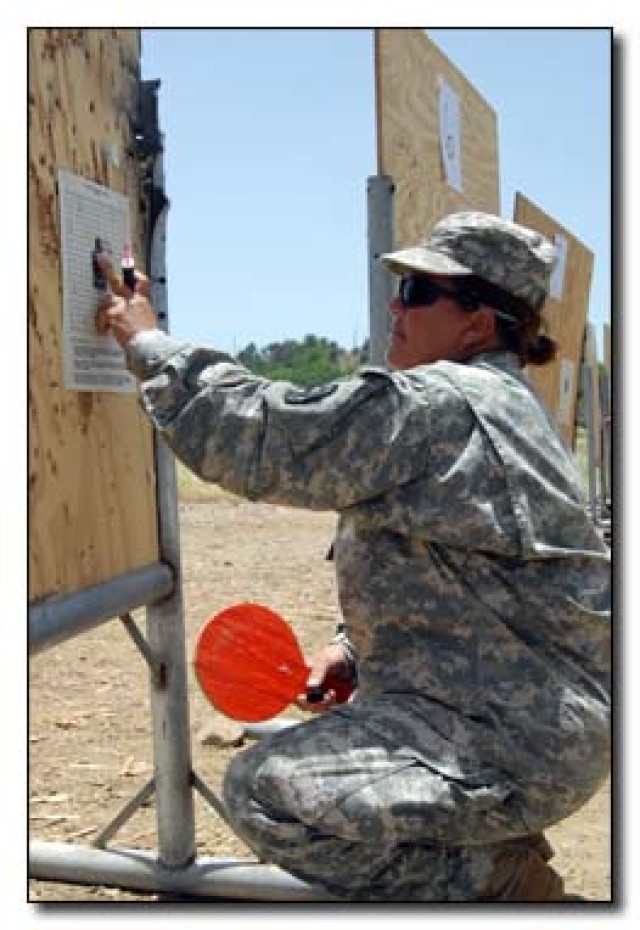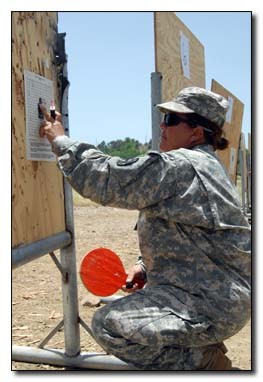
GUANTANAMO BAY, Cuba (July 13, 2009) Aca,!" The front lines of the War on Terror arenAca,!a,,ct found in the desert sands of Cuba, but Joint Task Force Guantanamo service members still train like they are.
Recently, during an especially hot day, members of the Puerto Rico Army National GuardAca,!a,,cs 480th Military Police Company set up targets and conducted weapons instruction for some military policemen at JTF Guantanamo. The weapons of choice Aca,!" M-9 pistols and M-16 rifles; the SoldiersAca,!a,,c number one enemy Aca,!" the heat.
In an ongoing effort to make sure each service member completes annual weapons qualification, Soldiers are cycling through Grenadillo Range at U.S. Naval Station Guantanamo Bay. Different units take turns operating the ranges each week.
Aca,!A"We try to get as many [service members] as we can [qualified] each time,Aca,!A? said Sgt. 1st Class Mario Perez, the non-commissioned officer-in-charge.
Because of the extreme heat, precautions are taken to avoid dehydration and heat stroke. Camouflage netting provides shade for those waiting to fire, combat life savers are on hand to provide aid and evacuate casualties if needed and plenty of water is available to keep Soldiers hydrated while on the range.
When conducting ranges or any outdoor training or exercises, especially when the weather is hot, leaders should take into consideration the following hazards: heat category, level of exertion during training, individual risk factors for each service member and length of exposure and recovery time.
Service members who are more susceptible to heat injuries are: those who are not acclimatized to the heat, who have been exposed to more than one day of increased heat, increased exertion levels or lack of quality sleep; service members in poor physical condition, who are overweight or have a minor illness; service members who are taking medications, or have used alcohol in the last 24 hours; and those with a history of heat illness or who are over 40-years-old.
Leaders should constantly monitor their service members for signs of dehydration, including dizziness, headache, nausea, unsteady walk, weakness or fatigue and muscle cramps. More serious symptoms can include high body temperature, confusion, agitation, vomiting, convulsions, weak or rapid pulse, unresponsiveness and coma.
Perez considered many other risks Aca,!" including rough terrain, the potential for brush fires and possible ammunition hazards Aca,!" prior to conducting the range in accordance with Army Risk Assessment protocols. Each identified hazard was assessed and controls were put into place to mitigate or minimize the risk each posed. Inherent in each weapons range is the potential for injury due to accidents or weapons malfunctions. These risks can be minimized by using proper weapons safety procedures.
Weapons safety on the range is important. Proper safety procedures can enhance safe, realistic live-fire training, protect personnel and property and avoid injury and significant property damage.
Since 2005, approximately 15 Soldiers Aca,!" Army wide Aca,!" have died as a result of improperly handling a privately owned weapon. Nine of the 15 accidents involved alcohol and six involved a Soldier intentionally pointing what they thought to be an unloaded weapon at themselves.
In addition to treating every weapon as if it is loaded, Soldiers must understand that proficiency with the assigned military weapon does not make them an expert on all weapons.

Social Sharing